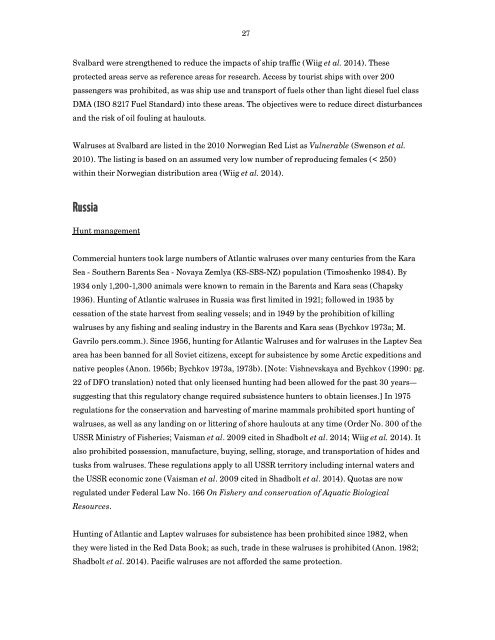The State of Circumpolar Walrus Populations
walrusreport
walrusreport
Create successful ePaper yourself
Turn your PDF publications into a flip-book with our unique Google optimized e-Paper software.
27<br />
Svalbard were strengthened to reduce the impacts <strong>of</strong> ship traffic (Wiig et al. 2014). <strong>The</strong>se<br />
protected areas serve as reference areas for research. Access by tourist ships with over 200<br />
passengers was prohibited, as was ship use and transport <strong>of</strong> fuels other than light diesel fuel class<br />
DMA (ISO 8217 Fuel Standard) into these areas. <strong>The</strong> objectives were to reduce direct disturbances<br />
and the risk <strong>of</strong> oil fouling at haulouts.<br />
<strong>Walrus</strong>es at Svalbard are listed in the 2010 Norwegian Red List as Vulnerable (Swenson et al.<br />
2010). <strong>The</strong> listing is based on an assumed very low number <strong>of</strong> reproducing females (< 250)<br />
within their Norwegian distribution area (Wiig et al. 2014).<br />
Russia<br />
Hunt management<br />
Commercial hunters took large numbers <strong>of</strong> Atlantic walruses over many centuries from the Kara<br />
Sea - Southern Barents Sea - Novaya Zemlya (KS-SBS-NZ) population (Timoshenko 1984). By<br />
1934 only 1,200-1,300 animals were known to remain in the Barents and Kara seas (Chapsky<br />
1936). Hunting <strong>of</strong> Atlantic walruses in Russia was first limited in 1921; followed in 1935 by<br />
cessation <strong>of</strong> the state harvest from sealing vessels; and in 1949 by the prohibition <strong>of</strong> killing<br />
walruses by any fishing and sealing industry in the Barents and Kara seas (Bychkov 1973a; M.<br />
Gavrilo pers.comm.). Since 1956, hunting for Atlantic <strong>Walrus</strong>es and for walruses in the Laptev Sea<br />
area has been banned for all Soviet citizens, except for subsistence by some Arctic expeditions and<br />
native peoples (Anon. 1956b; Bychkov 1973a, 1973b). [Note: Vishnevskaya and Bychkov (1990: pg.<br />
22 <strong>of</strong> DFO translation) noted that only licensed hunting had been allowed for the past 30 years—<br />
suggesting that this regulatory change required subsistence hunters to obtain licenses.] In 1975<br />
regulations for the conservation and harvesting <strong>of</strong> marine mammals prohibited sport hunting <strong>of</strong><br />
walruses, as well as any landing on or littering <strong>of</strong> shore haulouts at any time (Order No. 300 <strong>of</strong> the<br />
USSR Ministry <strong>of</strong> Fisheries; Vaisman et al. 2009 cited in Shadbolt et al. 2014; Wiig et al. 2014). It<br />
also prohibited possession, manufacture, buying, selling, storage, and transportation <strong>of</strong> hides and<br />
tusks from walruses. <strong>The</strong>se regulations apply to all USSR territory including internal waters and<br />
the USSR economic zone (Vaisman et al. 2009 cited in Shadbolt et al. 2014). Quotas are now<br />
regulated under Federal Law No. 166 On Fishery and conservation <strong>of</strong> Aquatic Biological<br />
Resources.<br />
Hunting <strong>of</strong> Atlantic and Laptev walruses for subsistence has been prohibited since 1982, when<br />
they were listed in the Red Data Book; as such, trade in these walruses is prohibited (Anon. 1982;<br />
Shadbolt et al. 2014). Pacific walruses are not afforded the same protection.


